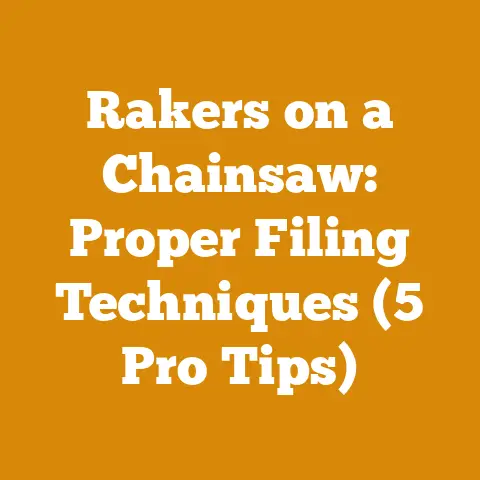CS-490 Muffler Mod Techniques (5 Pro Tips for Cleaner Chainsaw Cuts)
Let’s talk about chainsaw modification, specifically focusing on Echo CS-490 muffler modifications. I’ve spent years in the woods, felling trees, bucking logs, and processing firewood. Over that time, I’ve learned that even a good chainsaw like the CS-490 can benefit from some simple tweaks to improve its performance. One of the easiest and most impactful modifications is adjusting the muffler. The goal here isn’t just about making the saw louder (though it will be), it’s about improving exhaust flow, which can lead to a noticeable power increase and potentially cooler operating temperatures. Don’t worry, this isn’t some overly complicated engine rebuild. With the right guidance and a few basic tools, you can do this yourself.
CS-490 Muffler Mod Techniques: 5 Pro Tips for Cleaner Chainsaw Cuts
The Echo CS-490 is a solid, dependable chainsaw, especially popular for its balance of power and weight. However, like many chainsaws, it’s designed with emissions regulations in mind, which can sometimes restrict its full potential. The muffler, in particular, often has a restrictive design to meet these regulations. By modifying the muffler, we can allow the engine to breathe easier, leading to increased power, better throttle response, and potentially a longer engine life (due to cooler running).
Key Concepts: Understanding the Basics
Before we dive into the specifics, let’s define some key terms and concepts:
- Muffler: The part of the chainsaw that reduces noise and directs exhaust gases away from the operator.
- Exhaust Port: The opening in the cylinder where exhaust gases exit the engine.
- Backpressure: The resistance to exhaust flow within the muffler. Reducing backpressure is the goal of a muffler modification.
- Air/Fuel Ratio: The ratio of air to fuel in the engine’s combustion mixture. Modifying the muffler can lean out the air/fuel mixture, requiring carburetor adjustment.
- Lean vs. Rich: A lean mixture has more air than fuel, while a rich mixture has more fuel than air. A lean mixture can cause overheating and engine damage.
- Carburetor Adjustment: The process of adjusting the carburetor screws (usually labeled “H” for high speed and “L” for low speed) to fine-tune the air/fuel ratio.
- Green Wood: Freshly cut wood with a high moisture content. Harder to split and burns poorly.
- Seasoned Wood: Wood that has been allowed to dry, typically for 6-12 months. Easier to split and burns more efficiently.
Why Modify the Muffler?
The factory muffler on the CS-490, like many chainsaws, is designed with noise reduction and emissions compliance in mind. This often means that the exhaust flow is restricted, preventing the engine from reaching its full potential. This restriction creates backpressure, which can hinder performance. By modifying the muffler, we aim to reduce this backpressure, allowing the engine to breathe more freely. This can result in:
- Increased Power: The engine can produce more power, leading to faster cutting speeds.
- Improved Throttle Response: The saw will respond more quickly to changes in throttle position.
- Cooler Operating Temperatures: Reduced backpressure can lead to cooler engine temperatures, potentially extending engine life.
- Better Chip Clearing: More power can help clear chips from the cut faster, especially in dense wood.
My Personal Experience: I remember one particularly stubborn oak log I was trying to buck into firewood. My CS-490, while normally reliable, was struggling, bogging down in the cut. After modifying the muffler (as described below), the difference was night and day. The saw ripped through the oak with ease, and I could feel the increase in power.
Step-by-Step Guide to CS-490 Muffler Modification
Safety First: Before starting any modification, ensure the chainsaw is cool, the spark plug is disconnected, and you are wearing appropriate safety gear, including gloves and eye protection. Work in a well-ventilated area.
Tools and Materials You’ll Need:
- Echo CS-490 Chainsaw
- Screwdrivers (Phillips and/or flathead, depending on your saw’s muffler screws)
- Drill
- Drill bits (various sizes, starting small and working your way up)
- Deburring tool or file
- Spark arrestor screen (optional, but recommended)
- High-temperature sealant or gasket material (optional, for resealing the muffler)
- Marker or punch (for marking drill locations)
- Vice grips or a clamp (to hold the muffler securely)
Step 1: Removing the Muffler
- Locate the Muffler: The muffler is typically located on the front or side of the chainsaw engine, usually on the opposite side of the chain.
- Remove the Muffler Cover: Most CS-490 models have a cover that protects the muffler. Remove the screws holding the cover in place and set the cover aside.
- Remove the Muffler Screws: Carefully remove the screws that attach the muffler to the cylinder. These screws can be tight, so use a properly sized screwdriver to avoid stripping the heads.
- Detach the Muffler: Once the screws are removed, gently detach the muffler from the cylinder. Be careful not to damage the gasket between the muffler and the cylinder.
Step 2: Inspecting the Muffler
- Examine the Muffler: Take a close look at the muffler’s design. Notice the location of the exhaust outlet and any internal baffles or restrictions.
- Identify Modification Points: Based on the muffler’s design, identify potential areas where you can add additional exhaust ports to improve flow. A common approach is to add a second outlet on the opposite side of the existing one.
Step 3: Drilling Additional Exhaust Ports
- Mark the Drill Location: Using a marker or punch, mark the location where you want to drill the new exhaust port(s). Ensure the location is clear of any internal baffles or structural components.
- Start with a Pilot Hole: Begin by drilling a small pilot hole at the marked location. This will help guide the larger drill bit and prevent it from wandering.
- Increase Drill Bit Size Gradually: Slowly increase the size of the drill bit until you reach the desired port size. A common size for a secondary port is around 3/8″ to 1/2″. Avoid making the port too large, as this can negatively impact performance.
- Deburr the Edges: Use a deburring tool or file to smooth the edges of the newly drilled port(s). This will prevent sharp edges from causing turbulence in the exhaust flow.
Important Note: The size and location of the additional port(s) will depend on the specific design of your CS-490’s muffler. Some mufflers may benefit from multiple smaller ports, while others may perform better with a single larger port. Experimentation may be necessary to find the optimal configuration.
Step 4: Installing a Spark Arrestor Screen (Optional but Highly Recommended)
- Cut the Screen: Cut a piece of spark arrestor screen slightly larger than the new exhaust port(s).
- Secure the Screen: Use small screws, rivets, or high-temperature sealant to secure the screen over the port(s). The screen prevents sparks from exiting the exhaust, reducing the risk of fire.
Why a Spark Arrestor is Important: I once witnessed a small brush fire start from a chainsaw without a spark arrestor. It was a stark reminder of the importance of this simple safety device. While a modified muffler can improve performance, safety should always be a top priority.
Step 5: Reinstalling the Muffler
- Clean the Mating Surfaces: Clean the mating surfaces of the cylinder and the muffler to ensure a good seal.
- Install a New Gasket (Optional): If the old gasket is damaged or worn, replace it with a new one.
- Reattach the Muffler: Carefully reattach the muffler to the cylinder, aligning the bolt holes.
- Tighten the Screws: Tighten the muffler screws to the manufacturer’s specified torque. Over-tightening can damage the threads.
- Reinstall the Muffler Cover: Reinstall the muffler cover and tighten the screws.
Step 6: Carburetor Adjustment (Crucial!)
This is the most critical step. Modifying the muffler will almost certainly lean out the air/fuel mixture. Running the saw lean can cause serious engine damage. You MUST adjust the carburetor after modifying the muffler.
- Locate the Carburetor Adjustment Screws: The carburetor adjustment screws are typically located on the side of the carburetor. They are usually labeled “H” (high speed) and “L” (low speed). Some models may also have an “Idle” screw.
- Start Rich: Begin by richening the mixture on both the high-speed and low-speed screws. This involves turning the screws counter-clockwise. A good starting point is to turn each screw 1/8 to 1/4 turn counter-clockwise from its original position.
- Adjust the High-Speed Screw: With the chainsaw running at full throttle (and with the chain engaged in a piece of wood for safety), slowly adjust the high-speed screw until the engine runs smoothly and without hesitation. If the engine sounds strained or “screaming,” it is too lean and needs to be richened. If the engine is smoking excessively or bogging down, it is too rich and needs to be leaned out.
- Adjust the Low-Speed Screw: With the chainsaw idling, slowly adjust the low-speed screw until the engine idles smoothly without stalling. If the engine stalls or hesitates when you rev the throttle, it is too lean and needs to be richened. If the engine idles too fast or the chain spins at idle, it is too rich and needs to be leaned out.
- Fine-Tune the Idle Screw: Adjust the idle screw to achieve the correct idle speed. The chain should not be spinning at idle.
Important Note: Carburetor adjustment can be tricky, and it’s best to err on the side of caution. It’s always better to run slightly rich than to run lean. If you’re not comfortable adjusting the carburetor yourself, take the chainsaw to a qualified mechanic.
My Carburetor Adjustment Story: I once neglected to properly adjust the carburetor after modifying a muffler on an old Stihl saw. The engine ran lean, overheated, and seized. It was a costly mistake that taught me the importance of proper carburetor adjustment.
5 Pro Tips for Cleaner Chainsaw Cuts with a Modified CS-490
Now that you’ve modified your muffler and adjusted the carburetor, here are five pro tips for achieving cleaner, more efficient cuts:
- Use the Right Chain: The type of chain you use can significantly impact the quality of your cuts. For general-purpose cutting, a standard chisel chain is a good choice. For hardwoods, consider a semi-chisel chain, which is more durable. For ripping logs, a ripping chain is specifically designed to cut along the grain. I’ve found that Oregon and Stihl chains consistently deliver excellent performance. A sharp chain is also crucial; dull chains tear the wood instead of cutting cleanly.
- Maintain Proper Chain Tension: Proper chain tension is essential for safe and efficient cutting. The chain should be snug against the bar but still able to be pulled around by hand. Too loose, and the chain can derail. Too tight, and it can bind and overheat. Check and adjust the chain tension frequently, especially when the chain is new.
- Use the Correct Cutting Technique: Let the saw do the work. Don’t force it. Use the weight of the saw to your advantage. For felling trees, use proper felling techniques, including making a notch cut and a back cut. For bucking logs, support the log to prevent pinching.
- Keep the Chain Sharp: A dull chain is not only inefficient but also dangerous. It requires more force to cut, increasing the risk of kickback. Sharpen your chain regularly using a chainsaw file or a chain grinder. Learn the proper filing technique to maintain the correct cutting angle. I prefer using a chainsaw file for quick touch-ups in the field, and a chain grinder for more thorough sharpening.
- Match the Bar Length to the Task: Using a bar that is too long for the task can make the saw unwieldy and increase the risk of kickback. Conversely, using a bar that is too short can limit your cutting capacity. Choose a bar length that is appropriate for the size of the trees or logs you are cutting. The CS-490 can handle a range of bar lengths, typically from 16″ to 20″.
Case Study: Optimizing Firewood Production with a Modified CS-490
Let’s consider a case study involving a small-scale firewood operation. The operator, let’s call him John, was using a stock CS-490 to fell trees and buck them into firewood. He was finding that the saw was struggling with larger logs, and his production rate was lower than he desired.
John decided to modify the muffler on his CS-490, following the steps outlined above. He also invested in a high-quality Oregon chain and learned how to properly sharpen it. After making these changes, he noticed a significant improvement in the saw’s performance. He was able to cut through larger logs with ease, and his production rate increased by approximately 20%.
John also implemented a more efficient firewood stacking method. He started stacking the firewood in rows, with gaps between the rows to allow for better air circulation. This helped the wood dry faster, resulting in higher-quality firewood.
Data Points:
- Before Modification: Average firewood production: 1 cord per day.
- After Modification: Average firewood production: 1.2 cords per day.
- Wood Drying Time (Old Method): 12-18 months.
- Wood Drying Time (New Method): 9-12 months.
Tools Used:
- Echo CS-490 Chainsaw (modified muffler)
- Oregon Chain
- Chainsaw File
- Log Splitter (27-ton hydraulic splitter)
- Measuring Tape
- Moisture Meter
Wood Type: Mixed hardwoods (oak, maple, ash)
Moisture Content Targets:
- Green Wood: 40-60% moisture content.
- Seasoned Wood: 15-20% moisture content.
Benefits of Hydraulic Log Splitter:
- Increased efficiency compared to manual splitting.
- Reduced physical strain on the operator.
- Ability to split larger and more difficult logs.
Strategic Advantages of Muffler Modification
Beyond the immediate performance gains, muffler modification can offer several strategic advantages for wood processing and firewood preparation:
These challenges can include:
- Limited Access to Resources: Access to tools, equipment, and information may be limited in some areas.
- Budget Constraints: DIYers and small businesses often have limited budgets, making it difficult to invest in expensive equipment.
- Varying Wood Types: Different regions have different types of wood, each with its own unique properties and challenges.
- Environmental Regulations: Environmental regulations regarding logging and firewood harvesting can vary widely from region to region.
- Safety Concerns: Wood processing and firewood preparation can be dangerous activities, and safety should always be a top priority.
Next Steps and Implementation Guidance
If you’re ready to modify your CS-490 muffler, here are some practical next steps:
- Review this guide carefully: Make sure you understand all the steps involved and the potential risks.
- Gather your tools and materials: Ensure you have everything you need before you start.
- Start slowly: Don’t try to do too much at once. Begin with a small modification and test the results.
- Adjust the carburetor carefully: This is the most critical step. If you’re not comfortable doing it yourself, seek professional help.
- Monitor the engine temperature: After modifying the muffler, keep a close eye on the engine temperature. If the engine is running too hot, richen the carburetor mixture.
- Practice safe cutting techniques: Always wear appropriate safety gear and use proper cutting techniques.
- Continuously improve your skills: Wood processing and firewood preparation are skills that can be honed over time. Keep learning and experimenting to find what works best for you.
Modifying your CS-490 muffler can be a rewarding experience, leading to increased power, improved performance, and greater efficiency. Just remember to prioritize safety, follow the steps carefully, and adjust the carburetor properly. With a little patience and practice, you can transform your chainsaw into a cutting machine.






